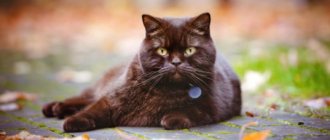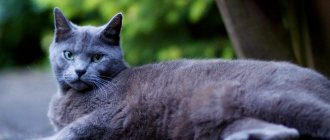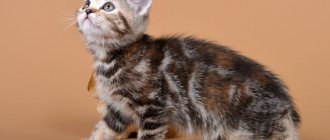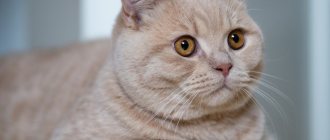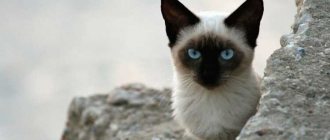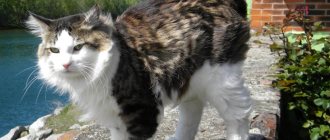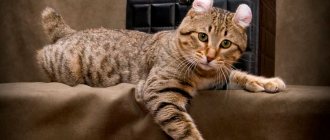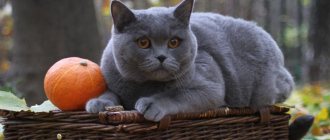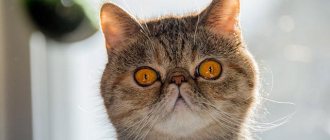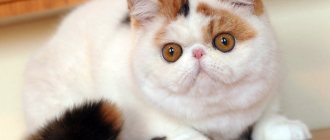| Country of origin | Great Britain |
| Dimensions | weight – 5-9 kg, height – 30-45 cm, body length – 55-65 cm. |
| Wool | short |
| Lifespan | 14-20 years old, average 12.5 years |
“Impressive”, “plump and round”, “teddy bears” - these are the names the British cat receives from its admirers. The British Shorthair cat breed is very popular in the UK and is one of the ten most popular in the world. The Cheshire cat with his famous smile described by L. Carroll in “Alice in Wonderland” is none other than the British Shorthair.
Origin story
It is believed that cats, which later became British, came to the islands of the same name back in the 2nd century BC. along with the Roman legionnaires. The breed developed under conditions of island isolation. And targeted breeding began only in the 19th century.
In 1871, the British Shorthair was officially presented at an exhibition in London, and in 1889 it received recognition as the British Blue.
While other colors were also considered breeds in Europe, the Americans remained adamant for a long time. The blue British woman was considered true. And only when a British black cat won the exhibition in 1968, other types of colors were recognized.
By the beginning of the 20th century. fashion has changed: they began to love Siamese and Persian cats more. The British population has declined sharply. After World War II, interest in the British cat breed increased, but there were only a few breeders. Therefore, the British were crossed with Persians, Russian Blues, and Carthusian cats. The result was new colors, a more powerful body and a rounder appearance.
From connections with the Persians, the British adopted one feature - the gene for long hair. It took several decades to get rid of it. But the kittens continued to be born with long hair. As a result, 2 types of British cats appeared: a shorthair and a second with fluffy hair, which transformed into a separate breed - the British Longhair or Highlander.
What to look for when choosing a pet?
Ears – growing straight and widely set. The tail is short and rounded at the tip, the paws are of medium length, strong and rounded.
The baby must be healthy, active, clean and well-groomed. There should be no foreign discharge from the eyes, nose or ears. Kittens' fur is usually smooth and velvety, soft to the touch, without pellets, tangles or bald spots. Make sure the kitten doesn't itch.
It is appropriate to ask for the kitten's pedigree and research the parents.
Choose a well-fed and strong kitten, but be prepared for the fact that the cost of just such a baby may be higher.
Description of the breed
The British Shorthair is a large animal. A strong body, full cheeks, and a round head make the cat very impressive. Everything about the Briton is round: his head, eyes, paws and even the tip of his tail. The whisker pads stand out well, making the face smile.
The peculiarity of British cats is their late development. Animals acquire features that fully meet the standard only by 3-5 years.
What a British cat looks like that meets the standard is presented in the table:
| Become | Breed characteristics |
| Head | Big round. It has smooth outlines from any angle of view. Short, thick neck. A strong chin, which with the pads of the mustache fits into the correct oval. The nose is wide along its entire length, short. There is a small depression on the bridge of the nose. The cheeks are large and appear drooping. The ears are set wide apart, medium in size, with rounded tips. The ears are slightly tilted forward (approximately 35 degrees). The eyes are large and wide open. Color: copper, orange, gold. British color point cats can have blue eyes, while golden and silver cats can have green eyes. |
| Body | Powerful with a wide chest, squat. A wide bone indicates breed qualities. |
| Legs | Medium length or short, strong. The paws are round. |
| Tail | Thick with a rounded tip, medium length. |
| Wool | Very dense, plush, short. Does not adhere to the body. The undercoat is well developed. The ideal texture is when, when stroking against growth, the fur does not move behind the hand. |
The head is given the greatest attention when assessing breed qualities.
Flaws:
- long nose, hump;
- the shape of the head is not round, but more like a box;
- narrow ears, falling apart to the sides, too large (hare ears), turned back;
- slanted eyes;
- insufficiently full cheeks;
- undershot;
- fox face due to the elongated nose, slanted eyes and weak chin.
Smoky colors
“Smoky” can be any of the colors, the main thing is that the undercoat should be lighter than the main color, preferably white. This is one of the varieties of hair color distribution. About half of the hair is colored, and closer to the root half is white. There are also “cameo” colors, in which the color of the undercoat almost merges with the color of the main hairs.
Classic smoky
“Smoke” is superimposed on the same solid coat colors: black-red, chocolate-red, blue-cream, lilac-cream, as well as cinnamon-red and fawn-cream. The undercoat is silvery-white.
Smoky bicolor
The cat has a symmetrically and harmoniously distributed white color and “smoky” spots of any color. The undercoat is white, the nose and paw pads match the base color.
British Fold
There is an expression "loose-eared British", but this species does not exist. There are 2 breeds - the British Shorthair and the Scottish Fold. A separate variety of the latter is identified - the Scottish straight-eared (Scottish Straight), which is also called the pointed-eared.
All of these breeds are closely related and were once bred to each other. But in 2004, the WCF introduced a ban on mating Scottish and British cats.
"Whiskas"
A valuable type of color, characterized by clear stripes covering the entire body of the cat, is the Whiskas color. The pattern should be as clear and contrasting as possible.
Features of character and behavior
Habits and character are the factors that make British cats popular.
Main character traits:
- balanced people do not like to show unnecessary emotions;
- unperturbed;
- peace-loving;
- devotees.
Cats have a truly English character. They have a sense of tact and self-esteem. They are not intrusive and will not bother the owner. At the same time, they love affection.
The British are not curious and well-mannered. This is inherent in them at the genetic level. But they don’t like to be controlled, picked up, or burdened with something.
The characteristics of the breed include tolerance. Because of this, the British woman gets along well with children. However, the cat does not like to be squeezed and dragged. He treats other animals calmly, even dogs.
They are distinguished by their developed intelligence and practically do not need education. Even small kittens that have just begun to walk quickly learn to use the toilet. However, adult animals are difficult to train.
Kittens are very active and playful. By the age of 4-5 years, an adult cat becomes slower. He prefers to watch what is happening from a convenient place and not get in the way.
In adulthood, when activity decreases, you need to monitor your pet’s weight.
Nevertheless, the hunting instinct is highly developed. Despite its massive size, the British cat is agile and fast. The reaction speed can be especially noticeable when hungry. The awkward heavyweight becomes quick and graceful in a second to get to the bowl.
Care and maintenance
Thanks to their thick fur coat, the British always have a neat appearance. However, they require regular care.
British cats need to be taught to groom from infancy.
| Procedure | Recommendations | Periodicity |
| Rub your eyes | The eyes are wiped with a cotton pad moistened with boiled, lukewarm water. The problem of leaking eyes is typical for newborn kittens and babies under 1 year old. | Daily |
| Examination and cleaning of ears | Ear cleaning is carried out only superficially as it gets dirty. | Inspection daily |
| Teeth cleaning | The British breed is prone to dental and gum disease. Therefore, it is necessary to brush your teeth with a special paste and brush. | 1 time per week |
| Combing | It is better to use an antistatic comb with a medium distance between teeth. First comb in the direction of hair growth, then in the opposite direction. Slickers often damage the plushness of the coat, so their use is not recommended. During shedding, you can remove dead fur with a latex glove. | 1-2 times a week. During molting period daily. |
| Nail trimming | No more than 1.5-2 mm is cut off, only the white part, so as not to damage the blood vessels. | Once every 1-1.5 weeks |
| Bathing | Special shampoos are used. It is permissible to use dry shampoo to clean the coat once every 2-3 weeks and the coat will be perfect. | Once every 2-3 months |
In addition, the British Shorthair is perhaps the only smooth-haired cat that likes to be brushed against the grain.
An interesting fact about British cats is that they have the largest number of hair follicles per square meter. cm and means the thickest wool of all breeds.
Feeding
The British are prone to excess weight. This must be taken into account when creating a menu. With a natural diet, the basis of the diet is lean meat (beef, chicken), offal, cereals (rice, buckwheat), vegetables, dairy products, cottage cheese. When feeding homemade food, mineral supplements and vitamins are required.
Properly balancing a natural menu is difficult. Therefore, preference is given to premium and super premium dry food. These foods already contain all the necessary vitamins.
When a kitten is taken to a new home, at first you cannot radically change the brand of food. This can lead to intestinal upset. The transition to a new diet should be gradual. Over the course of several days, mix the new food into the old one, gradually increasing its amount.
The kitten is fed 4-5 times a day or food is left freely available. By 1 year, the number of feedings is reduced to 2 times a day.
The animal should always have water. Preferably soft, cleaned. Hard, chlorinated tap water can serve as a provoking factor for the occurrence of urolithiasis.
British cat health
Overall, the British Shorthair is a healthy breed compared to other cats. However, there is a tendency to certain diseases:
- Hypertrophic cardiomyopathy. Heart problems are more common in males than females.
- Blood clotting disorder.
- Gum diseases.
- Obesity.
Annual vaccination and proper nutrition are the main preventive measures against the occurrence of cat diseases.
At 8-12 weeks, kittens are vaccinated with a complex vaccine against panleukopenia, calicivirus, rhinotracheitis, rabies, and chlamydia. After 21 days, the vaccination is repeated. Subsequent vaccinations take place annually.
Tortoiseshell color
Basically, females are endowed with this complex and beautiful color, while males, if they have a tortoiseshell color, are sterile. Particularly appreciated is the presence of red or cream shades on the cat’s face in this color.
How to choose the right British kitten
Purebred British kittens are not sold in the transition or on the market. You can buy a purebred British breed kitten only from a certified nursery.
There is no point in watching a British boy before 1.5 months. At this age it is impossible to assess his appearance.
Many people believe that purebred blue British kittens should have orange eyes. This is a common myth because all babies are born with blue eyes. Color changes at 3-4 months. It is at this age that it is recommended to buy a kitten. The breeder has already given the first vaccinations, toilet training and independent feeding.
Based on the photo, you can reserve a kitten on the nursery’s website, but visiting it before purchasing is required.
Signs of a good nursery:
- Doesn't smell like urine, clean.
- There are many toys, play complexes, scratching posts.
- There is a nursery certificate and pedigree. There should be no Persians or Scots in the pedigree.
What to look for when choosing and what British Shorthair kittens should be like:
- playful, moderately well-fed;
- well-groomed and healthy;
- calm, not afraid to make contact.
The owner of the cattery will tell you basic information about the British Shorthair cat: principles of feeding, rules of care. And he will always be in touch to help if necessary.
How much do British kittens cost?
In many ways, how much a British cat costs depends on the cattery, the class of the kitten, and the color.
British kittens are divided into classes by the breeder:
- Pet (pet) is a pet, not for breeding and not for exhibitions. The price starts from $100, but largely depends on the color. So lilac, blue, whiskey costs from 100-150, gold, chinchilla - from $500.
- Breeding – kittens for breeding cost on average from $300 to $500.
- Show – kittens with a high quality rating. The price depends on the color and on average varies from $500 to $2000. The most expensive because it is rare - gold British. Its cost is more than $2000.
Tabby colors
The main signs of a tabby (or wild color) are the letter M located on the animal’s forehead (according to legend, this is the sign of a scarab), dark stripes near the eyes and on the cheeks, as well as rings (necklace) on the neck and chest.
Marbled Tabby
Dark circles, swirls and patterns on a light background. The pattern should be clear, not tangled or intersecting.
Spotted Tabby
Stripes on the cheeks, a dotted stripe along the ridge, and spots on the sides, preferably clearly defined and bright, are required. The cat is a micro-leopard.
Striped tabby
Brindle (sprat, mackerel, striped) is the most common tabby color. Mackerel (mackerel) fish, as well as sprat fish, have tiger stripes on their scales, just like cats have on their fur, hence the name.
Distinctive features are a dark stripe along the ridge, extending onto the tail, and striped sides. It is important that the stripes are not interrupted and do not turn into spots. The cat is a micro-tiger.
Patterned with white (torbico)
Quite a rare color, consists of three: tabby, tortoiseshell, white. On a white background there are colored spots with one of the tabby patterns.
Pictured tortoiseshell (torby)
The animal has a tabby pattern under any of the coat colors (black-red, chocolate-red, blue-cream, lilac-cream, as well as cinnamon-red and fawn-cream).
Silver tabbies
The cat's fur has a black pattern (stripes, spots, marble), and a white and silver undercoat.
Golden tabbies
The cat's fur has a red pattern (stripes, spots, marble), and an apricot undercoat.
Advantages and disadvantages
The British cat breed has many advantages and it is difficult to find its shortcomings.
Pros:
- Balanced, calm temperament.
- Does not require constant attention.
- They rarely meow.
- Easy care.
Disadvantages of the breed:
- Late development. Pedigree traits are finally formed only by 3-5 years of age.
- I don’t like it when a person causes “inconvenience”.
